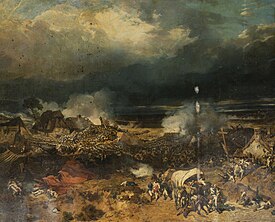| Battle of Wattignies | |||||||
|---|---|---|---|---|---|---|---|
| Part of the Flanders campaign in the War of the First Coalition | |||||||
 Battle of Wattignies by Eugène Lami | |||||||
| |||||||
| Belligerents | |||||||
|
|
| ||||||
| Commanders and leaders | |||||||
|
|
| ||||||
| Strength | |||||||
|
Engaged: 45,000 Jourdan: 45,000 Ferrand: 25,000 |
Engaged: 22,400 Observation Army: 37,000 Siege Army: 26,000 | ||||||
| Casualties and losses | |||||||
| 3,000–5,000 | 3,000 | ||||||
Location within France | |||||||
The Battle of Wattignies (15–16 October 1793) saw a French army commanded by Jean-Baptiste Jourdan attack a Coalition army directed by Prince Josias of Saxe-Coburg-Saalfeld. After two days of combat Jourdan's troops compelled the Habsburg covering force led by François Sébastien Charles Joseph de Croix, Count of Clerfayt to withdraw. The War of the First Coalition victory allowed the French to raise the siege of Maubeuge. At a time when failed generals were often executed or imprisoned, Jourdan had to endure interference from Lazare Carnot from the Committee of Public Safety. The village, renamed Wattignies-la-Victoire in honor of the important success, is located 9 kilometres (6 mi) southeast of Maubeuge.
Coburg's main army encircled 25,000 French soldiers in Maubeuge while about 22,000 Austrians under Clerfayt were formed in a semi-circle, covering the southern approaches to the fortress. On the first day, 45,000 French soldiers mounted a clumsy attack which was easily repulsed, except near the village of Wattignies. On the second day, Jourdan concentrated half his army at Wattignies and after a tough fight, forced Coburg to concede defeat. Though the Coalition army was better trained than the French, its units were spread out too thinly and the different nationalities failed to cooperate. Soon the Coalition army went into winter quarters, finishing a campaign that started with great promise and ended in disappointment. Carnot rewrote history so that he and the political representatives got most of the credit for the triumph; Jourdan was dismissed in January 1794.

